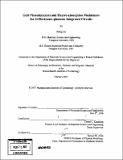| dc.contributor.advisor | Lionel C. Kimerling. | en_US |
| dc.contributor.author | Liu, Jifeng, Ph. D. Massachusetts Institute of Technology | en_US |
| dc.contributor.other | Massachusetts Institute of Technology. Dept. of Materials Science and Engineering. | en_US |
| dc.date.accessioned | 2008-11-10T19:49:17Z | |
| dc.date.available | 2008-11-10T19:49:17Z | |
| dc.date.copyright | 2007 | en_US |
| dc.date.issued | 2007 | en_US |
| dc.identifier.uri | http://dspace.mit.edu/handle/1721.1/38582 | en_US |
| dc.identifier.uri | http://hdl.handle.net/1721.1/38582 | |
| dc.description | Thesis (Ph. D.)--Massachusetts Institute of Technology, Dept. of Materials Science and Engineering, 2007. | en_US |
| dc.description | Includes bibliographical references (p. 185-188). | en_US |
| dc.description.abstract | The silicon electronic-photonic integrated circuit (EPIC) has emerged as a promising technology to break through the interconnect bottlenecks in telecommunications and on-chip interconnects. High performance photonic modulators and photodetectors compatible with Si complimentary metal oxide semiconductor (CMOS) devices are indispensable to achieve this goal. A photonic modulator generates optical "1" and "0" signals by switching the light on and off, while a photodetector converts the optical signals to electrical ones so that they can be processed by a CMOS circuit. Due to its compatibility with Si CMOS processing and adequate optoelectric properties, epitaxial GeSi material has been considered as a promising candidate to achieve this goal. This thesis investigates epitaxial GeSi photodetectors and electro-absorption (EA) modulators integrated with high index contrast Si(core)/Si02(cladding) waveguides to form an EPIC circuit on a Si platform with CMOS compatibility. Tensile strain is introduced into the GeSi material to enhance its optoelectronic properties. The effect of tensile strain on the band structure of Ge is systematically studied, and the deformation potential constants of Ge are derived from the experimental results with relatively high accuracy. | en_US |
| dc.description.abstract | (cont.) Methods to engineer the tensile strain in Ge are demonstrated. Tensile strain in small, selectively grown Ge mesas and stripes with at least one dimension <<10 jim is also investigated. The results are instructive to design selectively grown GeSi EA modulators and photodetectors integrated with Si/SiO2 waveguides. Free-space coupled Ge photodetectors on Si are fabricated with significantly improved performance in the L band (1561-1620nm) of telecommunications as a result of strain engineering. We have demonstrated a selectively grown Ge photodetector on a Si platform with a bandwidth of 8.5 GHz and a high responsivity over a broad wavelength range of 650-1605 nm. Full responsivity was achieved at 0 bias and full bandwidth was obtained at 1 V reverse bias, compatible with the requirement of Si ultra-large scale integrated circuits (ULSI). The GeSi EA modulator is based on Franz-Keldysh (FK) effect, where the electric field shifts the direct band edge of the GeSi material and significantly enhances its absorption coefficient in the weakly absorbing regime. Therefore, by modulating the electric field in the GeSi material, we can modulate the intensity of the light of a certain range of wavelength that passes through the GeSi material. A strain-enhanced FK effect in tensile strained epitaxial Ge material is demonstrated. | en_US |
| dc.description.abstract | (cont.) A waveguide-integrated GeSi EA modulator with 4.8 dB insertion loss, 9.8 dB extinction ratio and a bandwidth >50 GHz has been designed with the material composition and device structure optimized for operations around 1550 nm. The same material and device structure can be also used for waveguide-integrated photodetectors with a responsivity of 1.1 A/W at 1550 nm and a bandwidth >35 GHz. A method to monolithically integrate GeSi modulators, photodetectors and Si/SiO2 waveguides is proposed and the expected performance is evaluated. Waveguide-integrated GeSi photodetectors and EA modulators are fabricated on a standard 180 nm CMOS production line based on the design. We demonstrate a waveguide-integrated GeSi photodetector with a responsivity of 1.0 A/W at 1518 nm and a bandwidth >4.5 GHz, as well as a GeSi EA modulator with an extinction ratio of -0.3 dB. While the device performance of the EA modulator is far from ideal due to fabrication issues, the preliminary results demonstrate the feasibility of the electronic-photonic integration on a Si platform with GeSi modulator and detector devices. The problems in this first device processing are identified, and solutions are proposed and partially tested. The device performance could be greatly enhanced with improved processing technique. | en_US |
| dc.description.statementofresponsibility | by Jifeng Liu. | en_US |
| dc.format.extent | 190 p. | en_US |
| dc.language.iso | eng | en_US |
| dc.publisher | Massachusetts Institute of Technology | en_US |
| dc.rights | M.I.T. theses are protected by
copyright. They may be viewed from this source for any purpose, but
reproduction or distribution in any format is prohibited without written
permission. See provided URL for inquiries about permission. | en_US |
| dc.rights.uri | http://dspace.mit.edu/handle/1721.1/38582 | en_US |
| dc.rights.uri | http://dspace.mit.edu/handle/1721.1/7582 | en_US |
| dc.subject | Materials Science and Engineering. | en_US |
| dc.title | GeSi photodetectors and electro-absorption modulators for Si electronic-photonic integrated circuits | en_US |
| dc.title.alternative | GeSi photodetectors and EA modulators for silicon EPIC | en_US |
| dc.type | Thesis | en_US |
| dc.description.degree | Ph.D. | en_US |
| dc.contributor.department | Massachusetts Institute of Technology. Department of Materials Science and Engineering | |
| dc.identifier.oclc | 156789204 | en_US |
